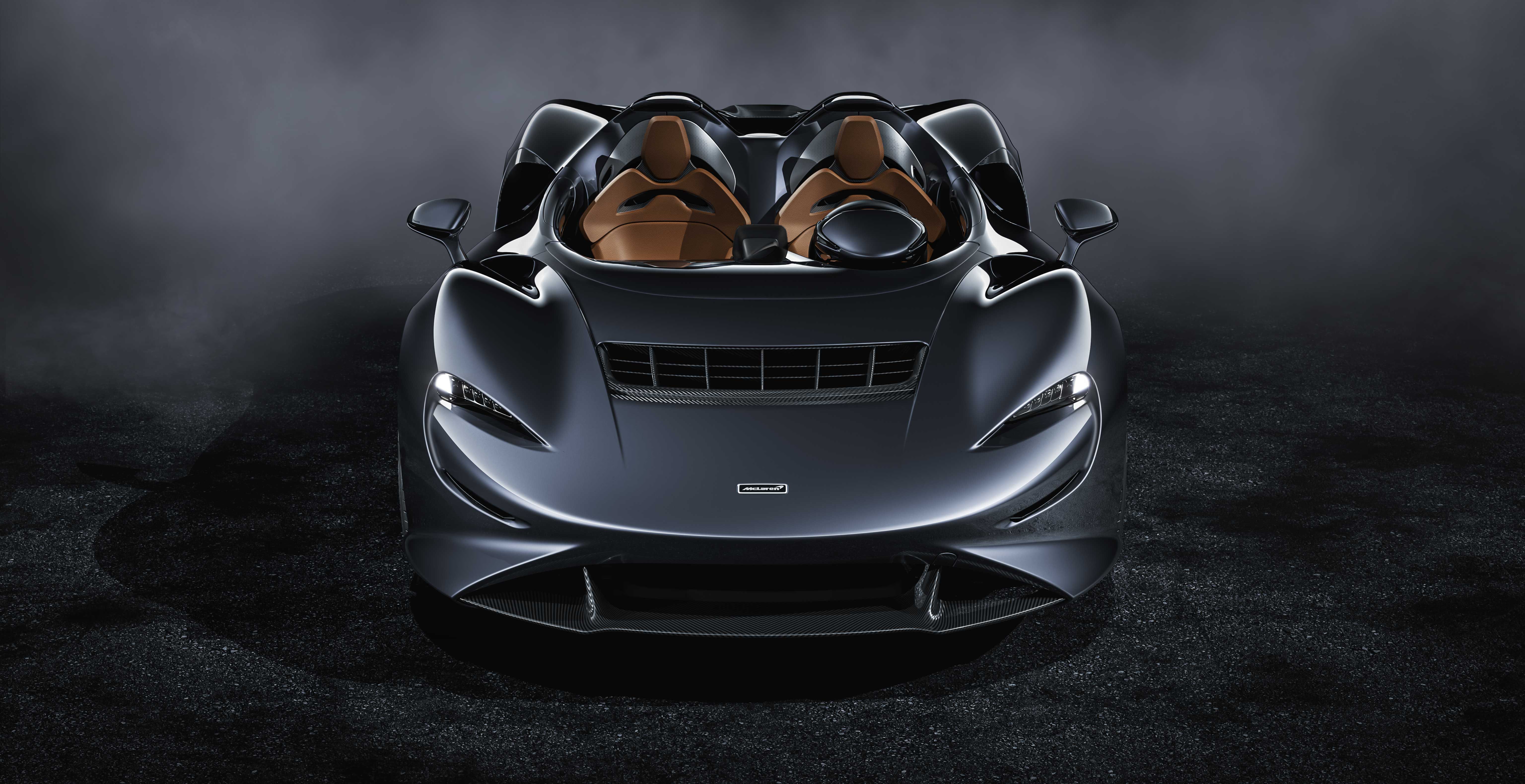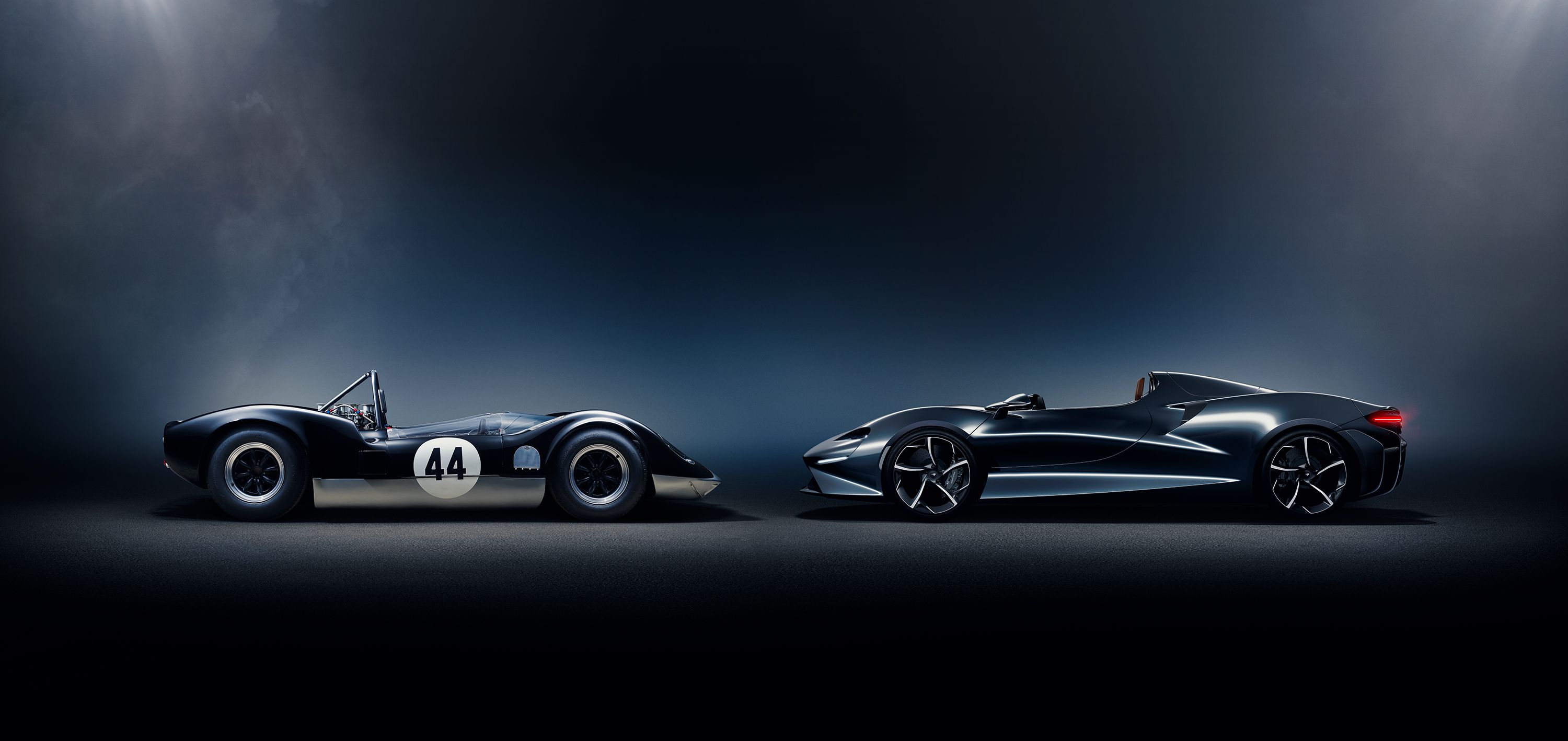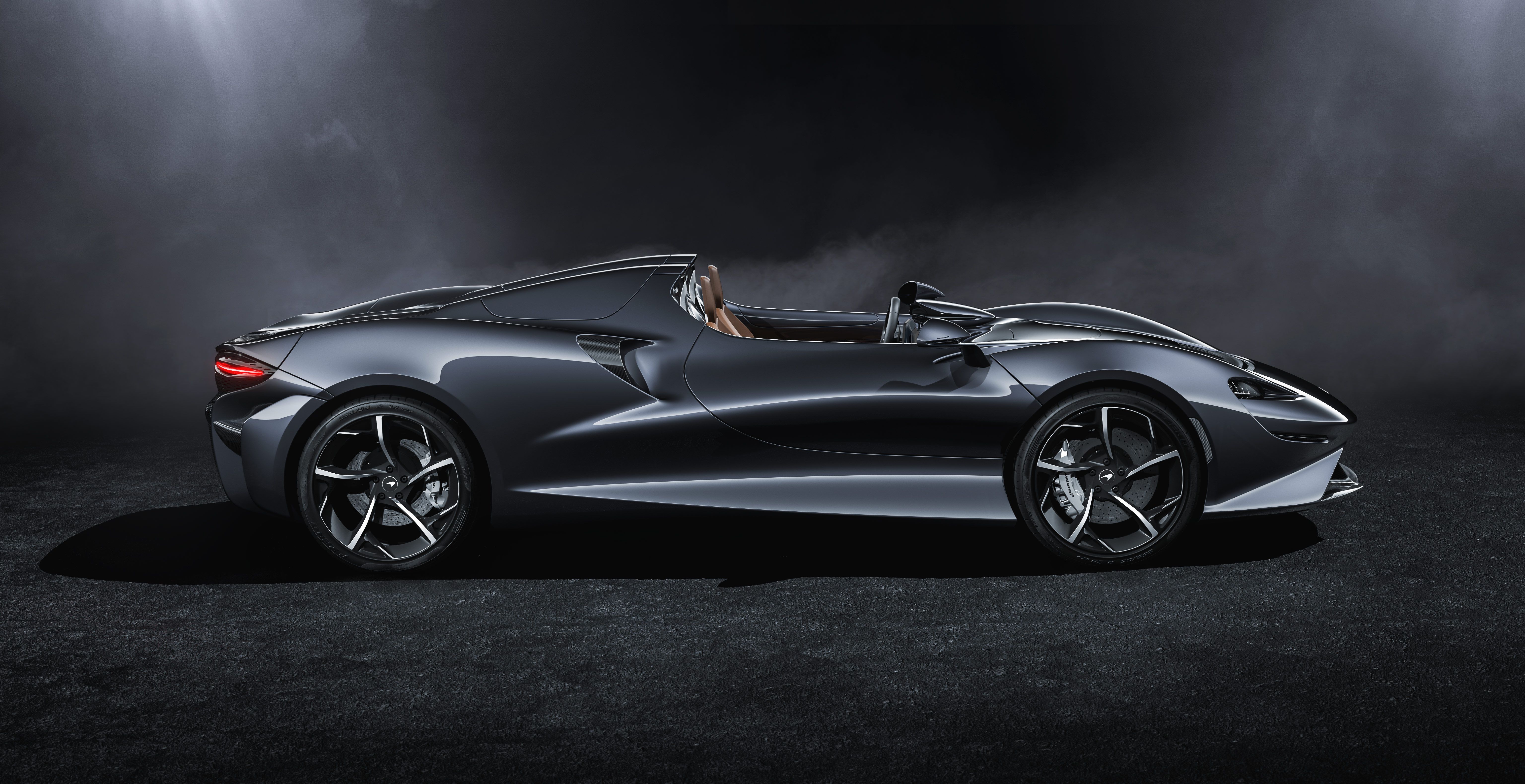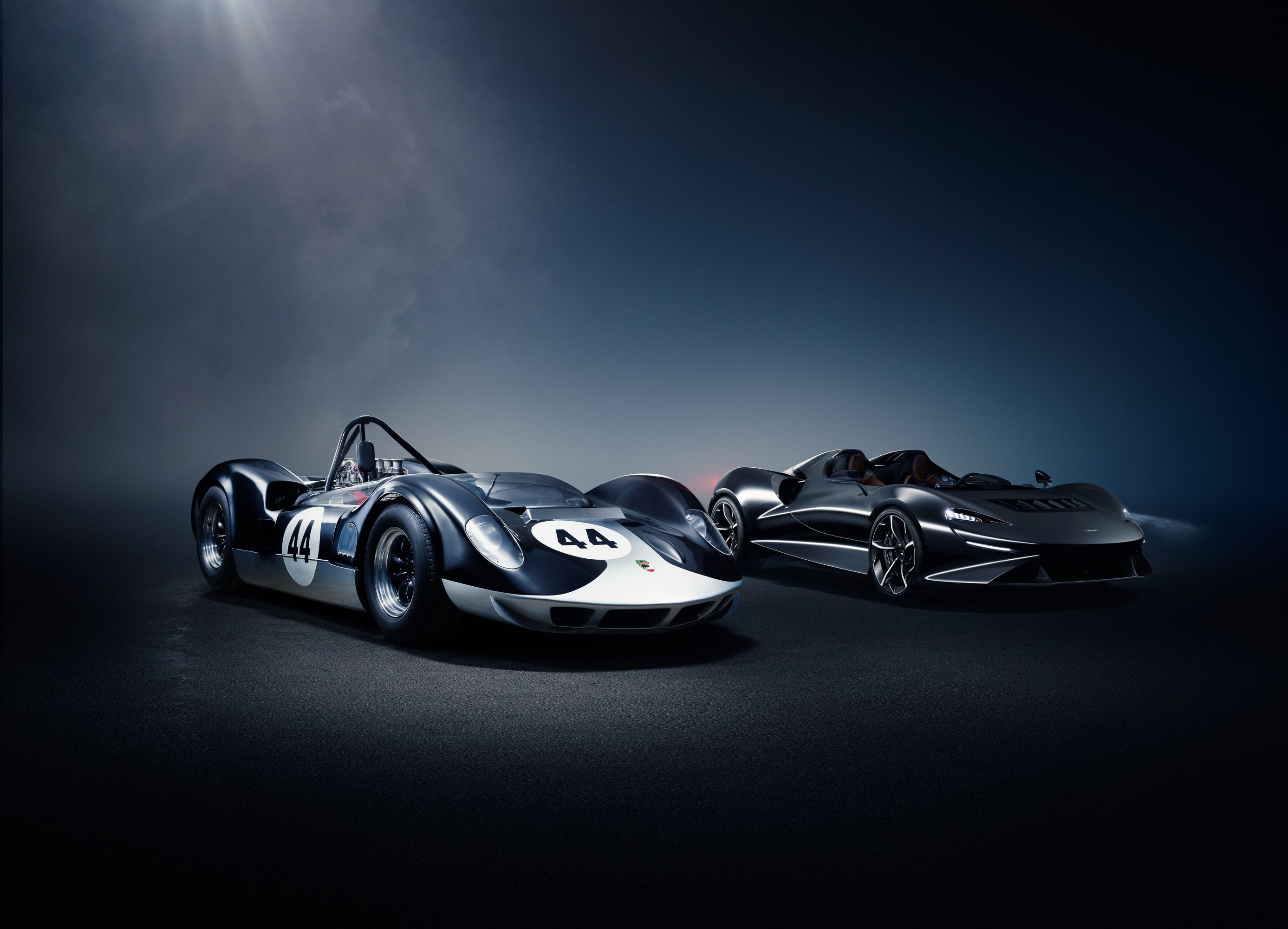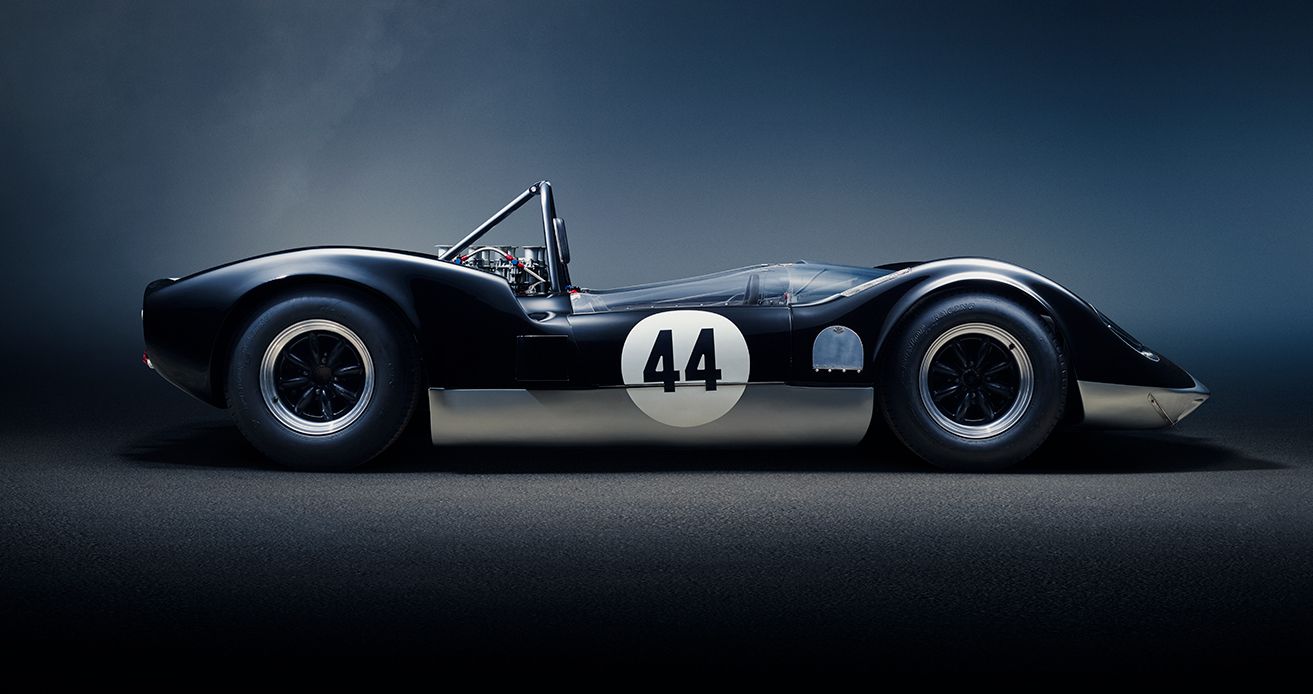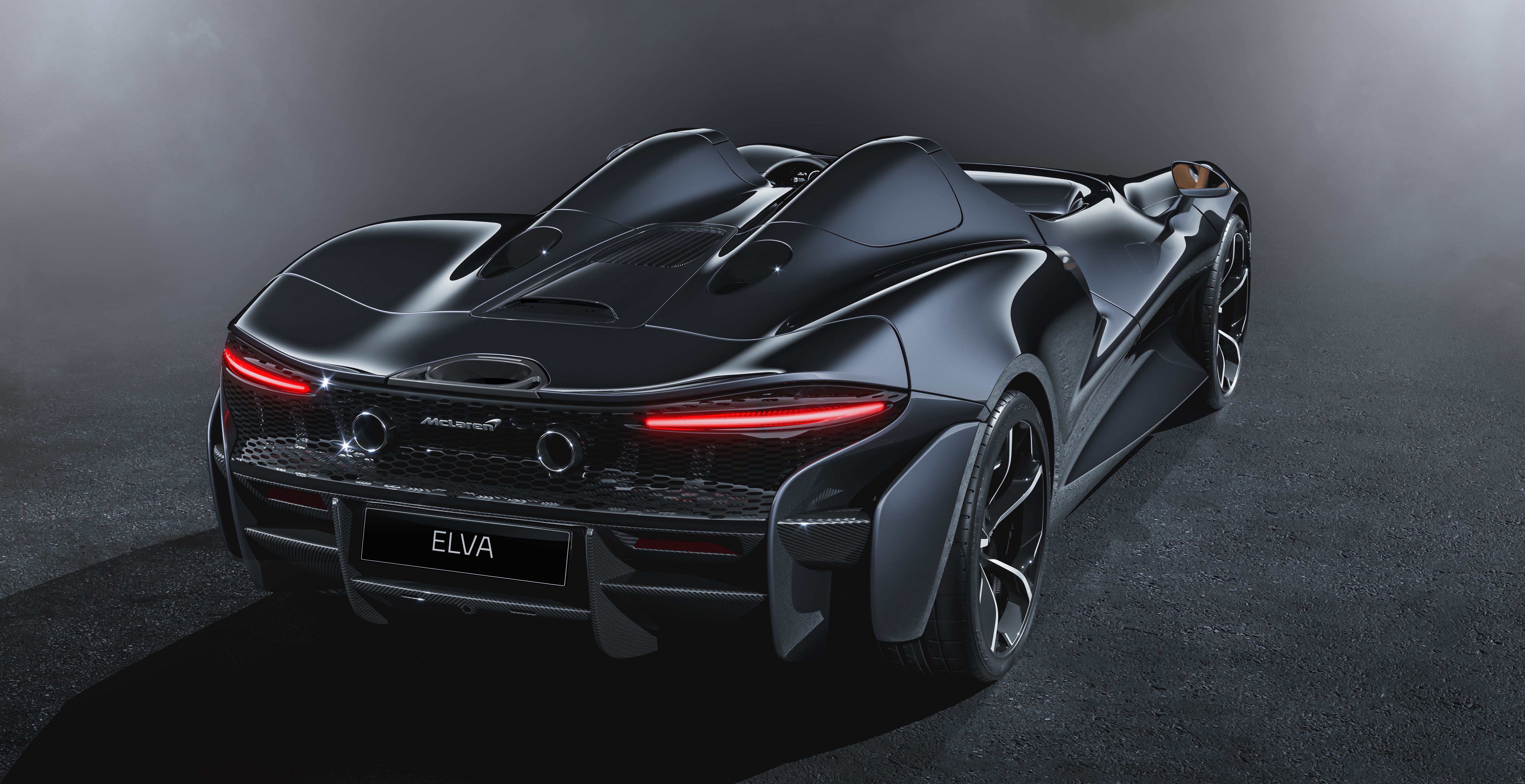For three decades, McLaren, the multi-championship-winning racing team from Woking, did not make one road car (Bruce's M6 GT notwithstanding). Then came Gordon Murray's F1, a car intended as a standalone product. Now, 27 years after the introduction of the ground-breaking F1, McLaren makes 10 different models and is one of the big players in the world of supercars. The Elva is the latest addition to the lineup, a $1.8-million, 804-horsepower drop-top beast - the first 100% topless McLaren. But its name lacks the usual combo of letters and numbers.
What's the link between a lithe sports car powered by BMW engines and built by a small British company and McLaren's latest Ultimate Series model? They both share the name and, more importantly, if it wasn't for the revival of that boutique manufacturer from England, there would be no McLaren today. This is McLaren's ode to Bruce's earliest forays as a car maker and here's the story behind that four-letter name.
McLaren channels Porsche with a throwback supercar
It's been almost a decade since McLaren introduced its first post-F1 road car, the clean-looking MP4-12C. It was the first car designed and built entirely by McLaren at its state-of-the-art facility in Woking. Featuring a carbon-fiber monocoque, it was powered by a McLaren-conceived twin-turbo V-8 good for 592 horsepower. A fine car by anyone's margin - albeit lacking the soul-gripping charisma of an Italian supercar - but, as we've now come to realize, it was merely a sign of things to come.
Take McLaren's latest wild child as an appropriate example. It looks like no other McLaren to come before it and its name is odd too. They named it 'Elva,' a nod to the French 'Elle Va' meaning 'She Goes'. As we'll detail below, the name's got nothing to do with McLaren's current or past nomenclature. No notable person in the company's history was named Elva.
If it'd done so, the 'Elva' would've, instead, been known as the 'Hunt' or the 'Lauda' or the 'Fittipaldi'. McLaren's already done it with the Senna, but we digress. Still, the source of the name is embedded deep in McLaren's long and storied history that dates all the way back to 1963. In fact, without Elva, Bruce McLaren might've never gotten around building cars bearing his own name.
First things first, however. Let's take a short look at how McLaren used to name its cars starting with the MP4-12C (the name of the F1 is self-explanatory). Walking in the footsteps of McLaren's F1 cars, the MP4-12C features the same naming format you'll find on post-1979 McLarens or, in other words, McLarens made after Ron Dennis took over the company and merged it with Project Four, his own team.
The 'MP4-XX' naming format stems from this merger with 'MP4' originally referring to 'Marlboro Project Four' as Marlboro became the team's driving sponsor around that time.
Thus, 'MP4' were now the initials for 'McLaren Project Four.' Since 2017, this whole naming system has been dropped (after Dennis finally stepped down for a second time and Zak Brown became the boss) and now each F1 car follows the 'MCLXX' nomenclature.
Before Dennis, the naming system was a lot simpler: you had 'M', standing for McLaren (or simply 'Mark', at first), followed by a number. The first McLaren road car, Bruce's personal M6 GT, was named according to that same nomenclature but the 'GT' part suggests it wasn't your average McLaren sports car. Nowadays, McLaren's alphanumerical system may be confusing but, last year, we found out that the Senna opened Pandora's Box - all future McLaren Ultimate Series models will sport proper names. So, let's take the proverbial time continuum-breaking DeLorean all the way back to the late '50s and find out why Elva was instrumental in the birth of McLaren Automotive.
New Zealander Bruce McLaren was born in Auckland in 1937. As a young boy, he displayed a keen interest in a variety of sports, acting as captain of his school's rugby team although he was drawing racing cars during school breaks. At age 9, he began to complain of growing pains in his left hip. Shortly afterward, doctors found out he was suffering from Perthe's disease (loss of blood circulation to the femur's head), a then-untreatable condition that confined Bruce to a specially made wheelchair featuring bicycle wheels for two full years. With weights hanging from his legs, he developed a limp as the affected leg wound up being shorter than the other.
Those years spent in between trips to the local Children's Hospital changed Bruce forever, making him a more introspective and quiet person than he had been before, coupled with a very deep and genuine sense of compassion that was felt by those working with him at McLaren where he singled himself out as the natural leader of the group not merely because he'd founded the company, but because of his demeanour, un-relinquishing optimism, and drive.
He gradually understood how the engine works and which part is responsible for what task and the way they all blend together into one functioning mechanical wonder. It was, then, no wonder that he'd sometimes sneak up on mechanics at the tracks his father used to race at and bag some wrenches to tinker on his own tricycle.
When he returned to school, Bruce duly participated in an engineering class, displaying unusual tenacity at hands-on jobs in the workshop from the get-go. Soon, the tricycle grew into an actual car as his father got him a 1929 Austin 7 Ulster which the two of them transformed into a race car, wrenching at the diminutive British people carrier whenever possible. Bruce learned to drive behind the wheel of the Ulster and was a license holder by the age of 15, in 1952. That was also the year he began taking part in sanctioned racing events with his small Austin, setting the fastest time at the Muriwai Beach Hill Climb in '53 after arduous work was poured into improving the Ulster's unremarkable performance.
The Austin was exchanged for a Cooper Formula Junior car brought back to New Zealand by Jack Brabham, driver for John Cooper's team back in Europe who saw the potential in McLaren and decided to support him, both financially and on a personal level. Bruce becoming his 'pupil' in the racing world as well as a friend. The connection led to McLaren's departure to Europe, facilitated by the fact that the New Zealand Auto Club named Bruce its first recipient of the 'Driver To Europe' contest whereby an up-and-coming New Zealander would be aided in his quest to reach the peaks of success in Europe, considered to be at the forefront in the world of car racing at the time.
The move happened in 1958 and McLaren proved Brabham's gut instincts were bang on the money by learning tremendously quickly despite a steep learning curve that presented itself in front of him as he arrived in England. He amassed a number of Formula 2 participations in his first season overseas, losing the F2 crown to Brabham himself at the year's end. More notably, he was the first of the drivers competing in F2 machinery in the 1958 German GP. He was barely 21 at the time. The following year he got his first taste of F1 machinery.
During his first season over in Europe, as the story goes, he had to build the F2 car he'd subsequently drive for Cooper's team himself. Upon arrival at Cooper's base in Surbiton, he asked John Cooper if he could see his car, at which point Cooper pointed to the tube rack, "It's in there, boy," he smirked with the corner of his mouth while gripping his pipe. In '59, he played second fiddle to team leader Brabham who was en-route to claiming the first title for a rear mid-engined F1 car (and his first title as a driver). In the final race of the season, the U.S. Grand Prix held at Sebring Raceway in Florida, Brabham ran out of juice on the very last lap while in the lead.
It wouldn't be until 2003 that someone younger than Bruce won a GP and that person was Fernando Alonso (not counting here Troy Ruttman's 1952 Indy 500 win).
But Bruce didn't just stick to F1. He raced, as it was the norm back then, just about everything with four wheels attached to it. He first raced at Le Mans in 1959 piloting a Cooper Monaco with Jim Russell (the founder of the famous driving school). In 1951, he tackled the 12 Hours of Sebring for the very first time behind the wheel of a Maserati Tipo 63 that he shared with Walt Hansgen. The duo retired both under the Floridian sunshine and later in the year at Le Mans, McLaren finding time in between to compete in the Nurburgring 1,000-kilometer race alongside Scotsman Jim Clark who was drafted in by the Essex Racing Stable. At the end of '61, Jack Brabham left Cooper to take matters in his own hands and form his own team. By then, McLaren had already married Patty, a girl he'd been introduced to via his soon-to-be friend and confidant Eoin Young. Young was in Teretonga at the end of '58 when McLaren returned home to race in the local New Year events. The two bonded quickly and it was Young who wrote McLaren's biography years later.
In 1964, Charlie Cooper, who'd taken over Cooper Cars, was faced with a sinking ship as finances were drying out. This forced him to sideline work on a pair of single-seaters meant to compete in what would later become the Tasman Series. McLaren, who'd founded 'Bruce McLaren Motor Racing Ltd.' in 1963, resorted to entering Coopers he modified himself with help from American Teddy Mayer. The two came together as the second Cooper modified by the new team was driven by Tim Mayer, Teddy's brother. By then, Tyler Alexander had been drafted in as chief mechanic and Eoin Young acted as Bruce's secretary since "Graham Hill and everybody's got one" and thus McLaren could use a secretary too, although he couldn't quite pin down the job of a secretary at first.
Penske took a 1961-spec Cooper T53 F1 car, covered its cross-linked tube frame chassis with a luscious bodywork and went sports car racing with it. As the money for the whole shebang came from Zerex, the car would be known as the 'Zerex Special', or the 'Cheater Special' as his rivals would refer to it since it adhered to the letter of the rules in SCCA and USAC competition but not the spirit of the rules.
Basically, you needed to have covered wheels, a windshield, and two seats to have a sports car as coined by the rulebooks. However, there was no mention of the practicality or size of the seats and Penske was the first to notice the loophole and exploit it with the single-seater Zerex Special that featured a small jump seat hidden below the car's bodywork to the driver's left. McLaren had competed against the Zerex Special in late '62 when Penske first took the red machine out, beating a mob of angry drivers (backed by their team owners) in the L.A. Times Grand Prix at Riverside. In fact, Penske and the Cooper-based Zerex ran undefeated for the better part of '63 before mechanical gremlins stopped the record-setting string of victories. In a way, the Zerex Special was the gateway for the 'unlimited' Group 7 category although even Group 7 cars featured well-defined two-seater layouts.
When McLaren took ownership of the Zerex, the car was still powered by the puny 2.7-liter Climax engine but it was enough for Bruce to win ahead of Jim Clark at Aintree from pole. Granted, Clark had to make do with the God-forsaken Lotus 30 and he also started from the back of the pack. The Lotus was, however, powered by a V-8 engine and McLaren soon heeded the warning. A new, wider frame was constructed by McLaren in-house to host a 4.0-liter Oldsmobile V-8 unit. Following the transformation, McLaren would enter the car as the 'Cooper-Oldsmobile' but, in fairness, it can be considered the first McLaren.
But the actual first McLaren came into being a little bit later, in the summer of '64 after Bruce recorded a couple more victories behind the wheel of the 'Cooper-Oldsmobile'. He figured that, with an even wider sports car powered by the same trustworthy Oldsmobile engine, he could go even faster and he decided to build a car from the ground up and have it ready before the Canadian GP for sports cars that took place on September 26th at Mosport Park. The decision was a clever one since McLaren had previously raced and won over there with the Oldsmobile-powered Zerex and this meant he could easily compare his new baby to the Zerex.
The new car, known as the Mark 1, was built in Feltham, near London Airport. With something like two months to spare, Bruce got to work right away and came up with the guiding sketches himself before handing over the baton to Cooper's Owen Maddocks who took care of the engineering aspects while Tony Hilder designed the body. Tyler Alexander and Wally Willmott fabricated the parts, including the chassis comprising of large-diameter, light gauge tubes for the main structure and magnesium for the undertray, with a steel front bulkhead. The first McLaren's Oldsmobile engine came with wet-sump lubrication to simplify things and steel bulkheads supported the suspension (lower wishbones in the front and an anti-roll bar) at each of the four corners.
The gearbox was a Hewland HD4 but the radiator was, surprisingly, of Chevrolet origin, namely a stock Corvette part - a reliable and cheap solution when almost a quarter of the price of an engine was represented by the Weber carbs.
McLaren started from the front row at Mosport with a car that was largely untested, going through just a single shakedown session at Goodwood before being shipped across the Atlantic. The only man who bettered Bruce's 1:30.6 qualifying effort was Jim Hall who slid through and posted a 1:29.5 with his Chaparral 2A powered by an aluminum 5.5-liter Chevy V-8. But Hall retired and McLaren finished third, three laps behind race winner Pedro Rodriguez and two behind runner-up Ludovico Scarfiotti, both driving Ferrari 330Ps entered by Luigi Chinetti.
This was enough for people to start knocking at McLaren's door with cheques at the ready for the Mark 1. There was, however, an issue. McLaren was still active in F1 and his team of mechanics and engineers was small, much too small to take on the difficult task of building a whole series of customer cars. Undeterred, McLaren struck a deal with Elva founder Frank Nichols for Elva to carry out the assembly of all customer cars, freeing McLaren from this burden and allowing his men to come up with improved designs - of which there were plenty.
Elva was a British race and road car manufacturer founded all the way back in 1955 by Frank Nichols. After racing a Lotus in a handicap race the year before, Nichols had the desire to make a light sports car he could call his own and that's why he founded Elva. The company started building diminutive open-top sports cars as well as Formula Junior single-seaters. These designs were progressively improved over time and proved hugely popular and successful around the world due to their simple architecture and flexibility.
In fact, a rather dated Elva Mk. VII S powered by a Porsche flat-four finished just two places behind McLaren in the Mark 1's debut race at Mosport. It's been said that about 1,000 Elvas were built in period and many of these were Couriers. The Elva Courier, Nichols' first proper road-going sports car, was unveiled in 1958. It all came about when Works Lister driver Archie Scott-Brown introduced Frank Nichols to a young ex-graduate called Peter Nott. The two came up with the Courier's design with money from a keen U.S. dealer who saw the Courier as a potential money-maker once sold Stateside.
In spite of the car's immediate success in native Britain, Elva capsized just a few short years later when its U.S. distributor ran out of money. This meant many cars were stuck in transit and others laid dormant awaiting their transfer in the New York docks. Forced into voluntary liquidation, the rights to the Elva name and the Courier were bought in 1961 by Trojan Limited, a company established in the '50s by Peter Agg to make bubble cars.
Trojan brought in much-needed capital to re-establish Elva and the customer McLarens became known as 'McLaren-Elva' although they were effectively manufactured by Trojan. The first customer version was the Mark 1-A (or M1A, in short). 24 M1As were built before production shifted towards the M1B and then the M1C. These sports cars were all two-seaters with wraparound Perspex screens, detachable doors, an onboard spare wheel (usually found atop the dash, below the windscreen), and a luggage compartment above the gearbox casing in the back. These faux creature comforts were all mandated by the regulations for '65 but, by '66, the liberal Group 7 rulebook would free sports cars of such useless appendages.
McLaren himself raced aboard the updated Works car throughout 1965 and there was a second car not built by Trojan, chassis #BMMR 2/64, that was entered by Dan Gurney under his All American Racers banner. The appearance of these (almost) uncompromising sports cars coincided with the launch of another iconic car, Lola's T70. The McLaren M1 and the T70 became natural rivals as Lotus' 30 and, then, the updated 40 simply couldn't keep up while the North American 'specials' lacked the reliability of these turn-key customer cars.
The 1965 edition of the Candian Grand Prix for sports cars was the scene of the Mark II's debut (later built by Trojan as the M1B), again in the hands of Bruce McLaren. The car started from pole but finished second, trailing Jim Hall's Chaparral at the end. The Chaparral was a special car in that Hall never sold any examples to a privateer. New Zealander Chris Amon was also on the grid that day and he drove the Ford GT-X1, a long-nosed, open-top version of the Ford Mk. II. At the end of 1965, The car was entered by McLaren himself, owing to his strong ties with Ford (he'd been instrumental in the development of the GT40 and racing for Ford took precedence over racing machinery bearing his own name.
The Mark I was also entered in a few long-distance races in the mid-'60s such as the Kyalami 9 Hours in South Africa. David Prophet qualified second for the race in 1965 but retired, while a bona fide endurance sports car, Ferrari's 365 P2, won in the hands of Richard Attwood and David Piper. For '66, the USRRC (United States Road Racing Championship) was superseded as America's top championship for sports cars by the Canadian-American Challenge Cup. The Can-Am was a series that attracted all of the star drivers of the '60s due to the sizeable purses up for grabs after every race (if you won the title, you made as much money as in five years racing for a leading F1 team).
McLaren duly entered with the Mark II-B (M1C in customer terms), encouraged by victories at Mosport (in the prestigious Player's 200) and Mt. Tremblant. Sadly, Bruce never won a race in '66 although he was always among the front runners. In the first event at St. Jovite, he qualified second behind John Surtees and had to look at the back end of Big John's Lola T70 for the entirety of the race, crossing the line five seconds in arrears. A third was all McLaren could do at Bridgehampton, a race won by Dan Gurney in a Ford-powered Lola T70 (the sole Ford victory in Can-Am's history). The return to Mosport yielded a frustrating retirement (Mark Donohue won in a Penske-entered Lola) for McLaren and another third-place finish was on the cards at Laguna Seca where Lola's dominance came to an end as Phil Hill won driving a Chaparral 2E.
Bruce started from pole at Riverside but retired. With Surtees scoring his second win of the year, McLaren's title hopes all but evaporated. Surtees won at Las Vegas (Stardust Raceway) to seal the title and Bruce came home right behind him. Luck would turn the way of McLaren, however, with the team changing its colors, losing 'Elva' from its name, and bouncing back stronger than ever with the M6A. Bruce took the Can-Am crown in '67 with that car and what followed was the 'Bruce and Denny Show' - four years of non-stop McLaren domination. McLaren walked away with the crown in '69 as well and Denny Hulme was champion in 1968 and 1970 before Revson picked up where the two had left off to win in 1971.
By then, however, Bruce had been gone for over a year, dying in a freak crash at Goodwood while testing the 1970 Can-Am car. However, privateers kept racing McLaren-Elva cars well into the early '70s while Trojan remained the sole builder of privateer McLaren cars, although no longer branded as 'McLaren-Elva' after the switch to the M6 platform. The last Trojan-built McLaren sports car was the M8F of 1972, a further evolution of the Works M8D. Trojan also designed the M12, an alternative to the factory's M8B for the 1969 season. A coupe-bodied M12 that was, by and large, a replica of McLaren's very own M6 GT, tried to qualify at Le Mans in 1981.
Between 1965 and 1972, when it tried its luck as a constructor of F5000 open-wheelers, Trojan built dozens upon dozens of McLaren customer cars. Their success varied upon the level of professionalism displayed by the teams that campaigned them. Numbers and results aside, it's undeniable that without Trojan, we wouldn't have had McLaren. Bruce's men could never have handled the demand that was out there for his creations and the whole thing could've crumbled.
As it was, however, McLaren could be sure of a constant cash flow via Trojan that helped it to expand and, ultimately, become a powerhouse in F1. Without its success in Can-Am and its success as a manufacturer of Can-Am (Group 7) cars, McLaren would've definitely delayed its F1 debut and its ascension to the sharp end of the field would've probably been slower. In the light of all this, it's no wonder McLaren bestowed upon its latest Ultimate Series model the honor of carrying the Elva name, one that deserves a lot more recognition than it has received over time.

